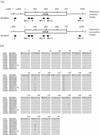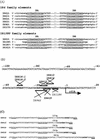New insertion sequence elements in the upstream region of cfiA in imipenem-resistant Bacteroides fragilis strains
- PMID: 12604530
- PMCID: PMC149317
- DOI: 10.1128/AAC.47.3.979-985.2003
New insertion sequence elements in the upstream region of cfiA in imipenem-resistant Bacteroides fragilis strains
Abstract
The 747-bp cfiA gene, which encodes a metallo-beta-lactamase, and the regions flanking cfiA in six imipenem-resistant and four imipenem-susceptible Bacteroides fragilis strains isolated in Japan were analyzed by PCR and DNA sequencing. The nucleotide sequences of the cfiA genes (designated cfiA(1) to cfiA(10)) of all 10 strains tested varied from that of the standard cfiA gene from B. fragilis TAL2480. However, putative proteins encoded by the cfiA variants contained conserved amino acid residues important for zinc binding and hairpin loop formation, suggesting that cfiA variants have the capability of producing metallo-beta-lactamases with full catalytic activities. PCR assay indicated that six metallo-beta-lactamase-producing, imipenem-resistant strains had an insertion mutation in the region immediately upstream of cfiA. Nucleotide sequencing of the PCR-amplified fragments along with the upstream region of cfiA revealed that there were five new kinds of insertion sequence (IS) elements (designated IS612, IS613, IS614, IS615, and IS616, with a size range of 1,594 to 1,691 bp), of which only IS616 was found to be almost identical to IS1188, one of the IS elements previously identified in the upstream region of cfiA. These elements had target site duplications of 4 or 5 bp in length, terminal inverted repeats (14, 15, or 17 bp in size), and a large open reading frame encoding a putative transposase which is required for the transcription of IS elements. Each element was inserted such that the transcriptional direction of the transposase was opposite to that of cfiA. A computer-aided homology search revealed that, based on the homology of their putative transposases, the sizes of their terminal inverted repeat sequences, and their target site duplications, IS612, IS613, IS614, and IS615 belong to the IS4 family, which includes IS942, previously found in some drug-resistant B. fragilis strains, but that IS616 belongs to the IS1380 family. All the IS elements appear to have putative promoter motif sequences (the -7 region's TAnnTTTG motif and the -33 region's TTG or TG) in their end regions, suggesting that the IS elements provide a promoter for the transcription of cfiA upon insertion. These data provide additional proof that various IS elements may exist to provide a promoter to express the cfiA gene.
Figures


Similar articles
-
Characterization of a carbapenemase-producing clinical isolate of Bacteroides fragilis in Scandinavia: genetic analysis of a unique insertion sequence.Scand J Infect Dis. 2005;37(9):676-9. doi: 10.1080/00365540510034482. Scand J Infect Dis. 2005. PMID: 16126569
-
Distribution of the cfiA gene among Bacteroides fragilis strains in Japan and relatedness of cfiA to imipenem resistance.Antimicrob Agents Chemother. 1999 Nov;43(11):2808-10. doi: 10.1128/AAC.43.11.2808. Antimicrob Agents Chemother. 1999. PMID: 10543771 Free PMC article.
-
Molecular characterization of imipenem-resistant, cfiA-positive Bacteroides fragilis isolates from the USA, Hungary and Kuwait.J Med Microbiol. 2004 May;53(Pt 5):413-419. doi: 10.1099/jmm.0.05452-0. J Med Microbiol. 2004. PMID: 15096551
-
Phenotypic and genotypic identification of carbapenem resistance in Bacteroides fragilis clinical strains.Med Microbiol Immunol. 2023 Jun;212(3):231-240. doi: 10.1007/s00430-023-00765-w. Epub 2023 May 13. Med Microbiol Immunol. 2023. PMID: 37178261 Free PMC article. Review.
-
IS982 and kin: new insights into an old IS family.Mob DNA. 2020 Jul 4;11:24. doi: 10.1186/s13100-020-00221-z. eCollection 2020. Mob DNA. 2020. PMID: 32641975 Free PMC article. Review.
Cited by
-
A Novel Selective Medium for Isolation of Bacteroides fragilis from Clinical Specimens.J Clin Microbiol. 2017 Feb;55(2):384-390. doi: 10.1128/JCM.01988-16. Epub 2016 Nov 16. J Clin Microbiol. 2017. PMID: 27852672 Free PMC article.
-
ISAba825, a functional insertion sequence modulating genomic plasticity and bla(OXA-58) expression in Acinetobacter baumannii.Antimicrob Agents Chemother. 2011 Feb;55(2):917-20. doi: 10.1128/AAC.00491-10. Epub 2010 Nov 22. Antimicrob Agents Chemother. 2011. PMID: 21098239 Free PMC article.
-
Strain-resolved microbiome sequencing reveals mobile elements that drive bacterial competition on a clinical timescale.Genome Med. 2020 May 29;12(1):50. doi: 10.1186/s13073-020-00747-0. Genome Med. 2020. PMID: 32471482 Free PMC article.
-
Anaerobic Gram-Negative Bacteria: Role as a Reservoir of Antibiotic Resistance.Antibiotics (Basel). 2023 May 22;12(5):942. doi: 10.3390/antibiotics12050942. Antibiotics (Basel). 2023. PMID: 37237845 Free PMC article.
-
First national survey of antibiotic susceptibility of the Bacteroides fragilis group: emerging resistance to carbapenems in Argentina.Antimicrob Agents Chemother. 2012 Mar;56(3):1309-14. doi: 10.1128/AAC.05622-11. Epub 2012 Jan 9. Antimicrob Agents Chemother. 2012. PMID: 22232282 Free PMC article.
References
-
- Bayley, D. P., E. R. Rocha, and C. J. Smith. 2000. Analysis of cepA and other Bacteroides fragilis genes reveals a unique promoter structure. FEMS Microbiol. Lett. 193:149-154. - PubMed
-
- Concha, N. O., B. A. Rasmussen, K. Bush, and O. Herzberg. 1996. Crystal structure of the wide-spectrum binuclear zinc β-lactamase from Bacteroides fragilis. Structure 4:823-836. - PubMed
MeSH terms
Substances
LinkOut - more resources
Full Text Sources
Miscellaneous

